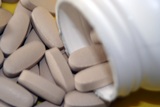Lyinâ Headline
Untangling Misleading Headline that Says Exercise Doesnât Rev Metabolism

Despite misleading headline, research has clearly shown that exercise does, in fact, increase metabolism.
If a Web site headline could be given a fine by the Newspaper Police for misleading the public, the amount collected on this one would be enough to save the dying newspaper business:Â Â âExercise not likely to rev up your metabolism.â
In January, I wrote an article about why it was important to avoid âall-or-nothing â thinking; how the notion of not going âall outâ or âfull throttleâ in an exercise session often leads people to pack it in and not do it at all.
Four months later, Iâm worried that kind of flawed thinking will resurface, as a recent report finds that exercise does not ignite the bodyâs metabolic rate â a study that flies in the face of years of research that says just the opposite.
The study comes out of the University of Colorado in Denver and it looked at approximately 65 men who engaged in low-intensity and high-intensity bicycling. The men varied in their fitness levels (from the moderately active, to the triathlete, to the sedentary; those who were thin as a rail, to those who were as big as a house), which gave the researchers comparisons as to how efficient their bodies were in burning fat, depending on whether or not they exercised on a given day and their physical makeup.
What they found was that whether the fellow was Phil the Fitness Freak, or Sid the Sedentary Sloth, there were no âsignificantâ differences in the menâs ability to burn fat in the 24-hour period after they exercised. Whatâs more, there wasnât much of a difference in fat-burning on the days that the men didnât exercise, either.
Now, for many people who just read the headlines of stories, this report â âExercise not likely to rev up your metabolismâ â would be all they needed to get out of the exercise excursion business altogether.
But thatâs why itâs so important to always look beyond the headlines, because the researchers themselves do some significant hedging of their bets with respect to their findings.
For instance, they say that peopleâs metabolic rate doesnât stay revved 24 hours after an exercise session. Yet they also point out that their participants engaged in moderate activity, cycling, and expending about 400 calories per session.
Go to any health club that has pre-programmed exercise sessions on their treadmill, stair climber or elliptical. Hit the âFat Burningâ button. Youâll notice that the fat burning exercise sessions are the ones that combine high intensity and low intensity in one exercise session â not low intensity for the entire session, or high intensity for the entire session, like these researchers had the participants perform.
So, in other words, fat burning was not high for their study, but that canât be universally applied to all exercise.
Secondly, the researchers try and dispel the notion that weight training revs up the metabolism with a rather flimsy argument. They say that while muscle burns more calories than fat â by a 10:2 ratio, in fact â few people put on enough muscle to burn a high number of calories.
Huh? So, whatever the researchersâ define as âfew,â thatâs enough for them to say conclusively that putting on muscle doesnât ignite someoneâs metabolism?
The fact is, people truly committed to their exercise regimens and who are able to put on pounds of muscle do kickstart their metabolism. Otherwise, how would they have been able to put on pounds of muscle in the first place?
Finally, the researchers say that while exercise does help with weight loss, one also has to consider diet; in other words, that itâs all about âcalories in vs. calories out.â
Who in the health world doesnât know that? Obviously, the more you take in, the greater need there is to work off those calories by exercising. But by exercising, youâre burning off the calories, and youâre also breaking down your bodyâs muscles so they can become stronger and more efficient in turning those calories into fuel for muscle tissue.
Trust me, I could go on, but Iâll keep my criticisms to three.
For all those who read this deceiving headline with some despair, I hope this breakdown has helped to clarify the issue. The benefits of exercise are manifold and even a little bit of it pays dividends.
Donât let a misleading headline bilk you into an all-or-nothing mentality.
Source:
Posted: May 26th, 2009 under Exercise.
Tags: exercise and metabolism, metabolism, metabolism boost
Comments: none


















